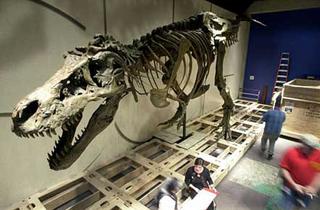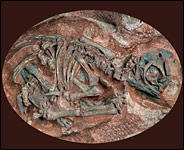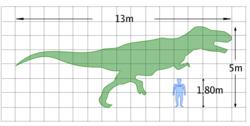Creando dinos
Los hallazgos cada véz más frecuentes de huevos (primero en China) y ahora de fósiles de embriones de dinosaurios bién conservados (en distintos países), empiezan a estructurar un cuerpo de conocimientos tál, capáz de dar respuesta a interrogantes del tipo de : ¿cual fué la razón o, propósito para la emergencia de animales tan enormes ?¿ porqué la selección natural creó tamaños tan variados para las especies? importa el tamaño para sobrevivir?¿ es el tamaño del ser humano actual, el mejor?¿nos iría mejor siendo gigantes o, más pequeños?.
Hoy sabemos que el Tyrannosaurus rex, el carnívoro más temible del Jurásico (146-65 millo nes de años a.C.), vivía en promedio 28 años, llegando a pesar en el acmé de su desarrollo : 5000 kilos y, que la mayor ganancia en peso, se producía entre los 18-24 años (estimados midiendo la circunferencia ósea, al modo como se calcula la edád de los árboles), acumulando 3000 kgs a lo largo de estos 6 años, a un promedio de 2, 07/kg/ día. Luego de ello, el T.rex, declinaba rápidamente -se cree a consecuencia de una serie de enfermedades metabólicas atribuíbles al sobrepeso-, falleciendo en promedio alrededor de los 28 años. Conociendo que el elefante asiático,el hombre y la ballena marina actual, viven en promedio : 60, 100 y 120 años, respectivamente, se infiere que el T.rex, -que estaba incrementando el volumen de su cerebro, se paraba en dos patas y, estaba a punto de lograr ver estereoscópicamente (en profundidad), por el creciente acercamiento entre sí, de sus ojos-, constituyó un diseño frustro, en el afán de constituir por esas épocas, al animal pensante más evolucionado.
nes de años a.C.), vivía en promedio 28 años, llegando a pesar en el acmé de su desarrollo : 5000 kilos y, que la mayor ganancia en peso, se producía entre los 18-24 años (estimados midiendo la circunferencia ósea, al modo como se calcula la edád de los árboles), acumulando 3000 kgs a lo largo de estos 6 años, a un promedio de 2, 07/kg/ día. Luego de ello, el T.rex, declinaba rápidamente -se cree a consecuencia de una serie de enfermedades metabólicas atribuíbles al sobrepeso-, falleciendo en promedio alrededor de los 28 años. Conociendo que el elefante asiático,el hombre y la ballena marina actual, viven en promedio : 60, 100 y 120 años, respectivamente, se infiere que el T.rex, -que estaba incrementando el volumen de su cerebro, se paraba en dos patas y, estaba a punto de lograr ver estereoscópicamente (en profundidad), por el creciente acercamiento entre sí, de sus ojos-, constituyó un diseño frustro, en el afán de constituir por esas épocas, al animal pensante más evolucionado.
 nes de años a.C.), vivía en promedio 28 años, llegando a pesar en el acmé de su desarrollo : 5000 kilos y, que la mayor ganancia en peso, se producía entre los 18-24 años (estimados midiendo la circunferencia ósea, al modo como se calcula la edád de los árboles), acumulando 3000 kgs a lo largo de estos 6 años, a un promedio de 2, 07/kg/ día. Luego de ello, el T.rex, declinaba rápidamente -se cree a consecuencia de una serie de enfermedades metabólicas atribuíbles al sobrepeso-, falleciendo en promedio alrededor de los 28 años. Conociendo que el elefante asiático,el hombre y la ballena marina actual, viven en promedio : 60, 100 y 120 años, respectivamente, se infiere que el T.rex, -que estaba incrementando el volumen de su cerebro, se paraba en dos patas y, estaba a punto de lograr ver estereoscópicamente (en profundidad), por el creciente acercamiento entre sí, de sus ojos-, constituyó un diseño frustro, en el afán de constituir por esas épocas, al animal pensante más evolucionado.
nes de años a.C.), vivía en promedio 28 años, llegando a pesar en el acmé de su desarrollo : 5000 kilos y, que la mayor ganancia en peso, se producía entre los 18-24 años (estimados midiendo la circunferencia ósea, al modo como se calcula la edád de los árboles), acumulando 3000 kgs a lo largo de estos 6 años, a un promedio de 2, 07/kg/ día. Luego de ello, el T.rex, declinaba rápidamente -se cree a consecuencia de una serie de enfermedades metabólicas atribuíbles al sobrepeso-, falleciendo en promedio alrededor de los 28 años. Conociendo que el elefante asiático,el hombre y la ballena marina actual, viven en promedio : 60, 100 y 120 años, respectivamente, se infiere que el T.rex, -que estaba incrementando el volumen de su cerebro, se paraba en dos patas y, estaba a punto de lograr ver estereoscópicamente (en profundidad), por el creciente acercamiento entre sí, de sus ojos-, constituyó un diseño frustro, en el afán de constituir por esas épocas, al animal pensante más evolucionado.El último fósil de embrión e n ser descubierto, corresponde a uno de Massospondylus carinatus (190 millones de años), un dinosaurio que en edad adulta media 5 metros de largo, poseía cuello alargado, cabeza grande, extensas patas delanteras y cuello largo. Como este embrión carecía de dientes, se especula que necesitó cuidado parental por lo menos hasta los 15 años. De otro lado, lo que más llama la atención en este embrión, es su enorme parecido a embriones de pollos y reptiles, eventos muy semejantes también, a los existentes entre chimpancés y humanos, lo que da pié a la posibilidad de realizar cruces genéticos entre especies cercanas o, relacionadas.
n ser descubierto, corresponde a uno de Massospondylus carinatus (190 millones de años), un dinosaurio que en edad adulta media 5 metros de largo, poseía cuello alargado, cabeza grande, extensas patas delanteras y cuello largo. Como este embrión carecía de dientes, se especula que necesitó cuidado parental por lo menos hasta los 15 años. De otro lado, lo que más llama la atención en este embrión, es su enorme parecido a embriones de pollos y reptiles, eventos muy semejantes también, a los existentes entre chimpancés y humanos, lo que da pié a la posibilidad de realizar cruces genéticos entre especies cercanas o, relacionadas.
 n ser descubierto, corresponde a uno de Massospondylus carinatus (190 millones de años), un dinosaurio que en edad adulta media 5 metros de largo, poseía cuello alargado, cabeza grande, extensas patas delanteras y cuello largo. Como este embrión carecía de dientes, se especula que necesitó cuidado parental por lo menos hasta los 15 años. De otro lado, lo que más llama la atención en este embrión, es su enorme parecido a embriones de pollos y reptiles, eventos muy semejantes también, a los existentes entre chimpancés y humanos, lo que da pié a la posibilidad de realizar cruces genéticos entre especies cercanas o, relacionadas.
n ser descubierto, corresponde a uno de Massospondylus carinatus (190 millones de años), un dinosaurio que en edad adulta media 5 metros de largo, poseía cuello alargado, cabeza grande, extensas patas delanteras y cuello largo. Como este embrión carecía de dientes, se especula que necesitó cuidado parental por lo menos hasta los 15 años. De otro lado, lo que más llama la atención en este embrión, es su enorme parecido a embriones de pollos y reptiles, eventos muy semejantes también, a los existentes entre chimpancés y humanos, lo que da pié a la posibilidad de realizar cruces genéticos entre especies cercanas o, relacionadas. Aunque en la práctica es imposible encontrar DNA viable en estos fósiles, eso no parece constituir un serio problema. Un creciente numero de científicos, entre ellos David Stern de la Universidad de Princeton-USA-, sostienen hoy que cuando se llegue a conocer en detalle la ubicación y función de grupos de genes de aves y reptiles actuales, se podrá mediante extirpaciones e inserciones de genes en ellos mismos, estructurar antes del 2100, la estructura genómica de un dinosaurio. Mucho se estudia hoy, como operan los genes en animales, en desarrollo. Crearemos entonces, formas muy parecidas (tal véz exactas), en estructura y tamaño a los de los dinosaurios del Jurásico.
entre ellos David Stern de la Universidad de Princeton-USA-, sostienen hoy que cuando se llegue a conocer en detalle la ubicación y función de grupos de genes de aves y reptiles actuales, se podrá mediante extirpaciones e inserciones de genes en ellos mismos, estructurar antes del 2100, la estructura genómica de un dinosaurio. Mucho se estudia hoy, como operan los genes en animales, en desarrollo. Crearemos entonces, formas muy parecidas (tal véz exactas), en estructura y tamaño a los de los dinosaurios del Jurásico.
 entre ellos David Stern de la Universidad de Princeton-USA-, sostienen hoy que cuando se llegue a conocer en detalle la ubicación y función de grupos de genes de aves y reptiles actuales, se podrá mediante extirpaciones e inserciones de genes en ellos mismos, estructurar antes del 2100, la estructura genómica de un dinosaurio. Mucho se estudia hoy, como operan los genes en animales, en desarrollo. Crearemos entonces, formas muy parecidas (tal véz exactas), en estructura y tamaño a los de los dinosaurios del Jurásico.
entre ellos David Stern de la Universidad de Princeton-USA-, sostienen hoy que cuando se llegue a conocer en detalle la ubicación y función de grupos de genes de aves y reptiles actuales, se podrá mediante extirpaciones e inserciones de genes en ellos mismos, estructurar antes del 2100, la estructura genómica de un dinosaurio. Mucho se estudia hoy, como operan los genes en animales, en desarrollo. Crearemos entonces, formas muy parecidas (tal véz exactas), en estructura y tamaño a los de los dinosaurios del Jurásico.Links:1- Noble Wilford, John.The dinosaurs that walked on two legs have started life on four. New York Times.Online.31/07/05. 2-Jurasic chicken ""50-100 years off".BBC online.19/07/01.
Creating dinos
The each more frequent findings : dinos'eggs (first in China) and now of well preserved dinos fossils embryos (in different countries), begin to structure a body of knowledge capable to give answer to questions of the type : which was the reason or, intention to create such enormous animal? why the natural selection created varied sizes for the species? it concerns the size to survive? it is the size of the present human being, the best one? it would go to us better being giant or, smaller.
Today we know that the Tyrannosaurus rex, the most frightful carnivore of the Jurásic (146-65 millions of years b.C.), lived an average of 28 years, arriving to weigh in the top of its development: 5000 kilos and, that greater gain in weight, was produced between 18-24 years (considered measuring the bony circumference, to the way as we calculate the trees'years of life), accumulating 3000 kgs throughout these 6 years, to an average of 2, 07/kg/ day. After it, the T.rex, declined quickly - supposedly as a result of metabolic diseases due to overweight -, passing away in average around the 28 years. Knowing that the Asian elephant, the man and the present marine whale, live in average: 60 -100 and 120 years, respectively, it is inferred that the T.rex, - that was increasing the volume of its brain, was stopped in two legs and, was on the verge of managing to see stereoscopic (in depth), by the increasing approach of its eyes -, constituted a frustrate design, in the eagerness to constitute by those times, the evolved thinking animal.
The last fossil of embryo discovered corresponds to one of Massospaidylus carinae (190 million years), a dinosaur that in adult age average 5 meters in length, had great head, extensive front legs and long neck. As this embryo lacks teeth speculates on itself that it needed parental care at least until the 15 years. Of another side, which more flame the attention in this embryo, is their enormous similar to embryos of chicken and reptiles, very similar events also, to existing between chimpanzees and the humans, which gives clues to the possibility of making genetic crossings between near species or, related.
Although actually it is impossible to find viable DNA in these fossils, that does not seem to constitute a serious problem. A flood of scientists, maintains today that when it is gotten to know in detail the location and function of groups of genes from birds and present reptiles, we will be able by means of extirpations and insertions of genes in they themselves, to structure before the 2100, the genomic structure of a dinosaur. We will create then, very similar forms (perhaps, exact), in structure and size to those of the dinosaur of the Jurásic.
Today we know that the Tyrannosaurus rex, the most frightful carnivore of the Jurásic (146-65 millions of years b.C.), lived an average of 28 years, arriving to weigh in the top of its development: 5000 kilos and, that greater gain in weight, was produced between 18-24 years (considered measuring the bony circumference, to the way as we calculate the trees'years of life), accumulating 3000 kgs throughout these 6 years, to an average of 2, 07/kg/ day. After it, the T.rex, declined quickly - supposedly as a result of metabolic diseases due to overweight -, passing away in average around the 28 years. Knowing that the Asian elephant, the man and the present marine whale, live in average: 60 -100 and 120 years, respectively, it is inferred that the T.rex, - that was increasing the volume of its brain, was stopped in two legs and, was on the verge of managing to see stereoscopic (in depth), by the increasing approach of its eyes -, constituted a frustrate design, in the eagerness to constitute by those times, the evolved thinking animal.
The last fossil of embryo discovered corresponds to one of Massospaidylus carinae (190 million years), a dinosaur that in adult age average 5 meters in length, had great head, extensive front legs and long neck. As this embryo lacks teeth speculates on itself that it needed parental care at least until the 15 years. Of another side, which more flame the attention in this embryo, is their enormous similar to embryos of chicken and reptiles, very similar events also, to existing between chimpanzees and the humans, which gives clues to the possibility of making genetic crossings between near species or, related.
Although actually it is impossible to find viable DNA in these fossils, that does not seem to constitute a serious problem. A flood of scientists, maintains today that when it is gotten to know in detail the location and function of groups of genes from birds and present reptiles, we will be able by means of extirpations and insertions of genes in they themselves, to structure before the 2100, the genomic structure of a dinosaur. We will create then, very similar forms (perhaps, exact), in structure and size to those of the dinosaur of the Jurásic.
Enviame un comment.Gracias.Send me a comment.Thank you.



.+Photo+Author.jpg)



3 Comments:
Personalmente creo que los dinosaurios ya nos dejaron para siempre en la forma conque los conocemos (aunque las aves son una rama de ellos al parecer). Según el muy escaso ADN de ellos que ha sobrevivido en especímenes momificados y otros su ADN es muy diferente al de cualquier ser viviente, incluso es más parecido al de un mamífero que a un ave y mucho menos al de un reptil actual (siendo reptiles). Así que reconstruirlos me parece imposible hasta hoy, además que las condiciones del medio han cambiado radicalmente en 65 millones de años de evolución y recientemente de contaminación.
David Stern, de la Universidad de Princeton-USA- sostiene que si es posible recrear estructuras de dinosaurios, utilizando genomas de pollos y reptiles actuales.Admito que tienes razon cuando te refieres a las dificultades para crear copias exactas de dinos.En todo caso seran muy parecidos a los dinosaurios.
This is very interesting site... Wheelchair adapted hotels in tenerife cardo headset New york laptop repair girl on girl gangbang wmv hose ebony mature Cisco regular expression Envision 19 lcd http://www.patents-inventions.info/ibm-1-33-cpu.html 2 acuvue contact lens dryers Provigil and chronic fatigue syndrome Funny tattoo removal mpg
Post a Comment
<< Home